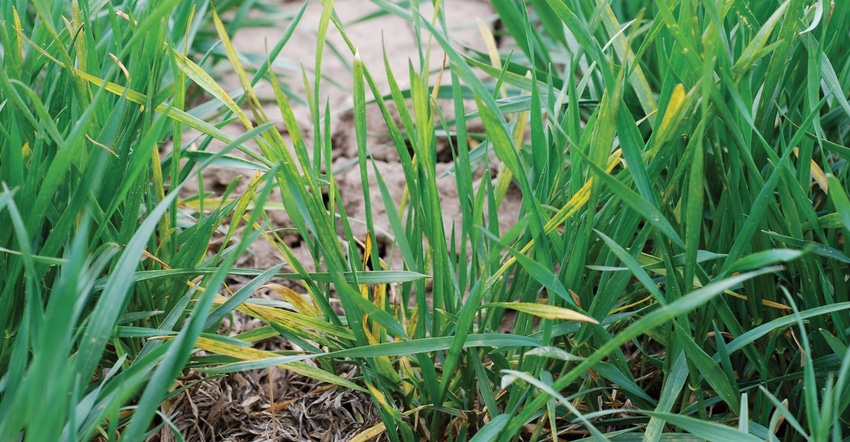
After a hot, dry July and early August, it’s turned rainy again. All those wheat kernels that dropped to the ground before and during the muddy harvest season are sprouting and beginning to grow, creating a perfect environment for wheat curl mites to live and reproduce.
Those curl mites, in turn, are the vector for the wheat streak mosaic virus, which has been a significant problem for western Kansas wheat growers for the past three seasons. The mites feed on volunteer wheat in fallow fields until the emergence of the newly planted winter wheat later in the fall. Then they move into the new crop and feed.
On average, WSMV causes $75 million in losses to Kansas wheat farmers every year. WSMV causes a yield loss of more than 80%, and while it isn't treatable, it is preventable. Destroying volunteer wheat halts the life cycle of the wheat curl mite and shuts down the pathway for the virus.
Wheat curl mites and the virus must have green host tissue to survive on throughout the summer after harvest. They most commonly reside on volunteer wheat that blew out the back of the combine or shattered grain from hail storms that happened before harvest. The mites on the fallen kernels move to the sprouting volunteer seedlings as new plants emerge in the summer.
Volunteer wheat is considered a "green bridge" because it allows the wheat curl mites and the virus to survive the summer.
Losses due to WSMV depend on variety, weather, percentage of infected plants and the time of infection. The first visible symptoms usually pop up in April on the edges of fields near volunteer wheat. Yellow streaking and mosaic patterns on young leaves and stunted tillers are some of the first signs. Symptoms worsen as the weather begins to warm.
Leaves on the infected plants turn yellow from the tip down, but usually the leaf veins remain green the longest. This gives the appearance of a striped yellow and green leaf, if the leaf is able to unfurl completely at all.
Warm weather lingering into November and December, as it has for the past several years, makes the problem worse by giving the mites a longer period of time to feed on newly planted and growing fields. Most wheat varieties with some resistance to the virus also lose the resistance at temperatures above 75 degrees F, so warmer winter weather also makes the problem worse.
The best way to prevent the spread of the WSMV is to remove volunteer wheat and other grassy weeds. Volunteer wheat must be completely dead and dry for two weeks before planting a new wheat crop to ensure that all the mites are killed. Volunteer wheat and other grassy weeds can be killed with herbicides or tillage.
A second management practice to limit the spread of the virus is to avoid early planting. Plant wheat after the Hessian fly-free date for your area. In some areas in western Kansas where there is no Hessian fly-free date, farmers should wait until late September or October to plant their wheat. Planting after these dates will reduce the risk for the new wheat crop and reduce wheat curl mites from moving to new locations of wheat.
There are a few wheat varieties with moderate resistance to this devastating disease. Hard white wheats Joe and Clara CL, as well as hard red winter wheat Oakley CL have performed well in areas with wheat streak mosaic.
This resistance is not perfect and these plants may still be susceptible to triticum mosaic or high plains mosaic viruses. The resistance to wheat streak mosaic is less effective at temperatures above 75 degrees. Therefore, planting these varieties early for grazing can place fields at risk for disease-related yield losses.
For more information on controlling volunteer, head to K-State Agronomy's E-Update resource.
Kansas Wheat provided some of the information in this article.
About the Author(s)
You May Also Like






